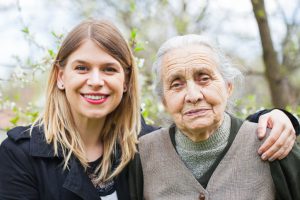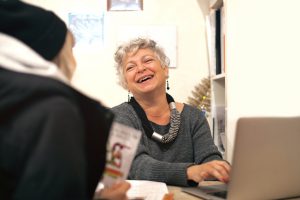 On Fridays, Stephanie*, a graduate student and hospice volunteer, visits Hettie*, a 78-year-old woman with Alzheimer’s disease. During these weekly visits, the duo discovers their own personalized form of connecting.
On Fridays, Stephanie*, a graduate student and hospice volunteer, visits Hettie*, a 78-year-old woman with Alzheimer’s disease. During these weekly visits, the duo discovers their own personalized form of connecting.
Hettie, who can’t speak, responds to conversation with Stephanie with a small hand gesture or head nod. Sometimes they watch The Chew, a cooking talk show, and Hettie will wrinkle her nose or make a face about certain recipes she doesn’t like.
But what Stephanie’s visits really do is give Hettie’s husband, Albert, an opportunity to run errands, get a haircut, or take a short break from caregiving for his wife.
Before Albert leaves the house, he always reminds Stephanie to do her homework if Hettie falls asleep. He knows Stephanie is in graduate school and encourages her to use Hettie’s nap time to study. When he returns, the first thing he asks Stephanie is if she finished her homework. He’s like an adopted grandfather to her.
The visit concludes with tea and cookies—a special time for both Stephanie and Albert, when the pair spends a few minutes chatting at the kitchen table. For her, it’s those simple moments of sharing fellowship that are so meaningful. For him, he enjoys the comradery and hearing about Stephanie’s studies. It’s a short break in the week that both look forward to. Stephanie firmly believes Hettie and Albert have enriched her life beyond measure and she is grateful for her time with them.
People choose to volunteer for a variety of reasons.
For Stephanie, there were two reasons. First, she was taught early in life by her mother, a pastor in the United Methodist Church, that it’s important to “hold space” with people—accept them for who they are and where they are—something commonly practiced in hospice and as a hospice volunteer. Years later, Stephanie was grateful for the presence and incredible support of the hospice team who took care of her mom when she was dying from cancer. She knew becoming a hospice volunteer was her calling.
People often become hospice volunteers because they are moved by the compassionate care their loved ones receive and they want to give back through volunteering. Volunteering allows them to contribute, be part of a good cause, and make their community a better place.
 Susan became a hospice volunteer after her mother received hospice care at home. She watched the compassionate hospice team care for her mom. Each day, the group of professionals offered thoughtful words and supportive actions to help her whole family through that difficult time. She knew right away that she wanted to join the team as a volunteer to replicate the kindness she and her mother experienced.
Susan became a hospice volunteer after her mother received hospice care at home. She watched the compassionate hospice team care for her mom. Each day, the group of professionals offered thoughtful words and supportive actions to help her whole family through that difficult time. She knew right away that she wanted to join the team as a volunteer to replicate the kindness she and her mother experienced.
Susan gives back by providing companionship to hospice patients each week. She values the time she spends getting to know a patient. She also believes, like Stephanie, that a benefit of volunteering is that each patient positively impacts her life as well.
Dorothy, an 85-year-old woman with cancer, lives in a local nursing home. As a hospice volunteer, Susan guides her wheelchair to the front of the community so she can enjoy views of the river and watch the boats go by. Dorothy talks about her day and the years she spent as a nurse. Susan listens contentedly to Dorothy reminisce and is reminded of a good life lesson—the importance of being present, and knowing when to be silent.
Next, Susan visits Mary, a 67-year-old woman with heart failure. The two spend hours laughing and chatting. Mary enjoys Susan’s company, and always thanks her profusely for visiting. After a few months, Mary nears death. As Mary drifts off to sleep at the end of their next visit, Susan pauses in the doorway and whispers “thank you.” She knows it will be the last time she will see her new friend, but she has cherished their time spent together. Connecting with patients like Mary makes Susan realize how precious life is and to treasure each moment with family and friends. It is one of the reasons she became a hospice volunteer. Susan is grateful for the relationships she builds with each patient.
Susan also became a hospice volunteer to be present and supportive for patients nearing death. As a vigil volunteer, she knows the special feeling of sharing those last precious moments with patients and their families, or sometimes with patients like Darryl. Darryl didn’t have any friends or family to visit him. His room at the facility was bare. There were no photographs or mementos. Susan pulled up a chair at his bedside and held his hand until he took his last breath. She became a hospice volunteer especially for moments like this—to be present, even if only for a short amount of time, and to offer a compassionate hand and a light touch so patients like Darryl know they are not alone.

People become hospice volunteers for many reasons. Many volunteer to express gratitude for help they received during their loved one’s illness. The benefit of engaging in this type of community service is that you’re making a difference where you live. You’re giving back, and you’re helping others. Helping others promotes satisfaction and self-worth. Plus, it’s good for your health—mind, body, and spirit.
Studies show doing regular volunteer work dramatically increases your life expectancy. As Allan Luks states in The Healing Power of Doing Good, volunteering improves your sense of well-being, decreases insomnia, builds a stronger immune system, and helps speed up recovery from surgery.
For others, enhancing your college or job application is a benefit of becoming a hospice volunteer. Volunteer service always reflects positively when a college or organization evaluates your resume. A study by Time Bank states 73% or employers would recruit a candidate with volunteer experience over one without.
Finally, meeting new people is a benefit of becoming a hospice volunteer. Helping at events, greeting guests at our inpatient hospice centers, and meeting other volunteers expands your social and professional networks to include more like-minded people. Meeting new friends creates more fun in your life, which also improves your health.
 I became a hospice volunteer because “I believe that it’s important to give back to your community and I do that by visiting hospice patients when they need company or their family caregiver needs a break.” – Taryn W.
I became a hospice volunteer because “I believe that it’s important to give back to your community and I do that by visiting hospice patients when they need company or their family caregiver needs a break.” – Taryn W.
I became a hospice volunteer because “I was a nurse for more than 30 years. When I retired, I wanted to find a way to still help people and volunteering for Samaritan fulfilled that desire.” – JS
I became a hospice volunteer because “Samaritan cared for my husband as he was dying from brain cancer. He was treated with respect and dignity, and I myself received emotional support from the staff. This experience led me to become a hospice volunteer.” – Joan K.
I became a hospice volunteer because of the “care my sister received. The courtesies that were extended to me and my family were exemplary.” – Leslie D.
I became a hospice volunteer because I wanted to give back after Samaritan treated “Mom with dignity and treated us, her family, with compassion and kindness. A few years later when my Dad entered hospice after his bout with cancer, Samaritan was there again, with helping hands and comforting words. We learned first-hand that hospice doesn’t have to be something to fear. ” – Ellen Kelleher
I became a hospice volunteer because “of the care my mom received. It made such an impact on me that I wanted to give back. This work meant something.” – Sally Cezo, Director of Volunteer Services
I became a hospice volunteer because “Samaritan cared for my grandfather who had ALS. He was a proud WWII veteran who didn’t want help from anyone – that is from anyone except his Samaritan certified home health aide. The staff built trust with him and their relationships transcended staff and patient. One year later, when my mom needed hospice, we immediately called Samaritan. We couldn’t have made it through these losses without Samaritan.” – Sharon Wenner, Volunteer Recruiter & Youth Coordinator
 Hospice volunteers have diverse opportunities to share their time and talents, whether in a patient’s home, in the office, or in the community. Some volunteers visit patients to offer companionship. Other volunteers help with administrative tasks such as data entry and filing. Volunteers greet guests at The Samaritan Center at Voorhees, assist at our two thrift stores, and serve on committees. Hospice volunteers can also be music performers or visit patients with their already-certified pet therapy dog!
Hospice volunteers have diverse opportunities to share their time and talents, whether in a patient’s home, in the office, or in the community. Some volunteers visit patients to offer companionship. Other volunteers help with administrative tasks such as data entry and filing. Volunteers greet guests at The Samaritan Center at Voorhees, assist at our two thrift stores, and serve on committees. Hospice volunteers can also be music performers or visit patients with their already-certified pet therapy dog!
If you’ve experienced a significant loss, we ask that you wait a year before volunteering. You do not have to be a healthcare professional to volunteer with Samaritan. We welcome you to bring the talents you already have, or if you’d like, broaden your horizons and learn new skills.
If you’re interested in volunteering, contact Sharon Wenner at 856-552-3238.
*names have been changed to maintain privacy